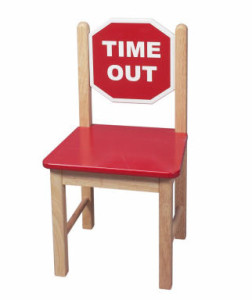 Time-out is often a hotly-debated topic. Is it too punishing? Where should it take place? How long should it last? There are not easy answers to many of these questions. But there are some evidence-based suggestions that may improve a time out procedure should you decide to use one.
Time-out is often a hotly-debated topic. Is it too punishing? Where should it take place? How long should it last? There are not easy answers to many of these questions. But there are some evidence-based suggestions that may improve a time out procedure should you decide to use one.
- First, know the function of the behavior! If the child is engaging in the undesirable behavior for escape, then providing “time out” will likely increase the behavior. For instance, if a child gets sent out of the classroom each time he curses, this is effectively a time out from classwork. He may curse because in the past, cursing resulted in escaping from classwork. This is an instance when you would not want to use time out. A time-out may prove to be effective for behaviors that function for attention or access to tangibles. More on that next…
- Consider a nonexclusion time-out procedure. In the past, we’ve discussed the time-out ribbon here. This is a useful tool for signaling to a learner that they have access to social or tangible reinforcers. If they engage in an inappropriate behavior, the ribbon is removed and they do not have access to social or tangible reinforcers, however they are still able to participate in the lesson or activity you have organized. It also allows them to practice more appropriate behaviors to earn the ribbon back. If the ribbon isn’t the best visual cue for your learner, you could make it anything this is visible for them and clearly delineates when they do and do not have access to reinforcement.
- Consider the use of a release contingency. This means that a learner is unable to leave time out until a predetermined amount of time has passed without problem behavior. Perhaps if you’re working with a preschool child who has been kicking other children, the release contingency might be that they must sit with “quiet feet” or “feet on the floor” for one full minute before they can go back to play. Your other option is to put in a fixed time contingency, which is best done by setting some sort of timer so the learner can see how much time is remaining in time-out.
- Combine time out with positive reinforcement procedures. Time-out by itself may result in decreases in behavior only when time out is a possibility. For instance, you may see a decrease in the problem behavior only when the child’s mother is at home, because the father doesn’t use time out. The goal is to decrease the problem behavior across all settings and activities. To that end, it’s helpful to teach appropriate replacement behaviors and reinforce the learner for engaging in those behaviors.
WRITTEN BY SAM BLANCO, MSED, BCBA
Sam is an ABA provider for students ages 3-12 in NYC. Working in education for ten years with students with Autism Spectrum Disorders and other developmental delays, Sam has developed strategies for achieving a multitude of academic, behavior, and social goals. Sam is currently pursuing her PhD in Applied Behavior Analysis at Endicott College.

 The time-out ribbon may be an excellent solution for just those types of instances. When Foxx and Shapiro (1978) first wrote about the time-out ribbon, they referred to it as “nonexclusionary time-out,” meaning the individual does not have to be excluded from an environment or activity to be “in time-out.” In their initial study, all students wore a ribbon on their wrist. When the individual has the time-out ribbon on, they have access to socially-mediated reinforcement. If the time-out ribbon is removed, they do not have access to that reinforcement. (Foxx & Shapiro also note that it does not have to be a ribbon, but could be anything that is easy to wear and easy to remove.) However, by again demonstrating appropriate behavior, the ribbon can be placed again on the individual’s wrist.
The time-out ribbon may be an excellent solution for just those types of instances. When Foxx and Shapiro (1978) first wrote about the time-out ribbon, they referred to it as “nonexclusionary time-out,” meaning the individual does not have to be excluded from an environment or activity to be “in time-out.” In their initial study, all students wore a ribbon on their wrist. When the individual has the time-out ribbon on, they have access to socially-mediated reinforcement. If the time-out ribbon is removed, they do not have access to that reinforcement. (Foxx & Shapiro also note that it does not have to be a ribbon, but could be anything that is easy to wear and easy to remove.) However, by again demonstrating appropriate behavior, the ribbon can be placed again on the individual’s wrist.